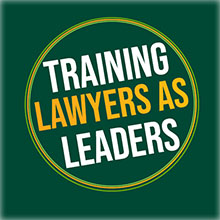
Newly adopted ABA Standard 303(b) reinforces the duty of law schools to help their students explore “the values, guiding principles, and well-being practices,” which are considered “foundational to successful legal practice” and fundamental to lawyers’ professional identity. Our Baylor Law Leadership Development Program was created in 2013 to provide structure to teaching law students about the lawyers’ role in society and better preparing them to serve their clients and society. These goals align with Standard 303(b) as well as the professional identity formation work occurring around the country. (See the work of the Holloran Center under the co-director of Professors Neil Hamilton and Jerry Organ).
Our Leadership Development Program addresses two other recent amendments: ABA Standard 303(c) (bias and cross-cultural competency & racism education), and 508(b) (student well-being resources). All three subjects (professional identity, bias and cultural competency, and wellness) are essential topics that need to be addressed as we prepare law students for the important work of lawyers in society. Finding all three topics in the textbook, Fundamentals of Lawyer Leadership, is no surprise and not an accident. With no law school textbook available when we started teaching leadership in 2013, we labored to determine what should be taught in a leadership course and program. Those three topics were recognized as fundamental to a well-rounded legal education.
We wrote the textbook and created the Teacher’s Manual and Resources to help others create a leadership course or present a program in whatever manner makes sense within their system and culture. With this easy-to-use textbook (and teaching materials), we hope more faculty and staff will join the growing movement to better prepare students to become more effective professionals and inspire them to be difference-makers.
Both the textbook and our own course structure are divided into four aspects of developing leadership. Following an introduction to the concept of leadership, we ask students to look internally first before turning the leadership focus outward. The course is formatted as follows:
- Part I – Overview of Leadership
Initial sessions introduce students to what we mean by “leadership” – a process whereby an individual has an influence on another (or a group) to achieve a common goal. Leadership is the opportunity to help and serve no matter what title or position one holds in an organization. Students should also recognize that lawyers in our society hold positions of leadership as they advise clients and organizations, and as they serve in their communities. Leadership is part of our professional identity. For materials relevant to the Standard 303(b) changes, see Fundamentals of Lawyer Leadership Preface, Chapter 2 (Why Lawyers Should Study Leadership). - Part II – Leadership of Self: Growing into Leadership
Students are guided through a process of self-discovery and assessment to gain a better sense of who they are and what type of lawyer and leader they want to be. Topics covered include characteristics of leadership (traits, skills, and competencies, including those traditionally developed in law school); growth mindset; grit and resilience; feedback and learning through failure; well-being; integrity and character; preparedness and setting goals. For materials relevant to Standard 508(b) changes, see Fundamentals of Lawyer Leadership, Chapter 11 (The Importance of Well-Being: Thriving in the Legal Profession). - Part III – Leadership with Others: Effective Group Dynamics
To be effective lawyers and leaders, students need to develop their ability to work and interact effectively with others. Topics in this part include emotional intelligence; relationships and influence; strategic communication; diversity and inclusion; unconscious bias and cultural competency; effective management; and working within legal organizations. For materials relevant to Standard 303(c) changes, see Fundamentals of Lawyer Leadership, Chapter 17 (Diversity, Inclusion, and Cultural Intelligence). - Part IV – Leadership within Community: Service and Impact
Lawyers are well suited, and expected, to use their legal training and other talents and gifts to serve society. We want to encourage students to seek opportunities to serve in ways that are meaningful to them and that can have a significant impact on others. Students are challenged to consider what legacy they want to leave. Chapters in this part can be used to emphasize leadership for positive change and encourage law students to use their legal skills to effectuate a desired goal.
This textbook is designed to make leadership and professional formation easy to implement and teach. Each chapter can be used as a module for stand-alone programs or incorporated into other courses. An abundant library of teaching materials (notes, exercises, PowerPoint slides, etc.) is available to accompany class sessions and to complement presentations.
To access the professor resources for this title, you will need a validated professor account on Aspen Publlishing. If you do not yet have a validated professor account, you may register at AspenPublishing.com/my-account/register. Account validation may take 1-2 business days. Once validated, you may log into your account using your own personal login, go to the relevant product page and scroll down to access the Professor Resources.
Thank you for your efforts to prepare and inspire law students to boldly seek opportunities to make a difference in our profession, their communities, and the world. Please let us know how we can help you!




